Aberthaw Tidal Power Station
2019 Outline Design by Edward Grist
(7) Engineering Design - Water Turbines and Storage Batteries
Contents
- Data Requirement
- Preliminary Selection of Water-Turbines
- Storage Batteries
- The Selection Process - 20MW batteries
- The Selection Process - 40MW batteries
Data Requirement
The evaluation of choice of the water-turbine design, its generating speed range and the magnitude of power output require the following data collection be undertaken first.- Measure accurately the contour of the Bristol Channel bed between Aberthaw and Minehead.
- Measure the rate of flow across the site of the barrage at 50 metre intervals. The measurements should be repeated every thirty minutes for 12 hours 20 minutes. The measurement should be repeated every 4 days for a lunar calendar month.
- Measure the concentration of sediment in suspension.
Preliminary Selection of Water-Turbines
With the advance work completed potential equipment suppliers can now make a preliminary selection from the range of designs they are willing to offer.- Cavitation
Cavitation in cold water being passed through a water-turbine or pump makes a characteristic ‘crackling’ noise. Visual observations in water at 2C and at 20C have revealed that cavities leading to a blockage in machine passages are large and noisy and few in number compared to water at 43C where noise is noticeably reduced and the number that caused blockage is much greater.
More important perhaps is the fact that between 2C and 43C the excess pressure over vapour pressure for the most efficient generation regime remains essentially the same. In other words, the margin (commonly described as the ‘Net Positive Suction Head’ NPSH) needed to express a safety from power generation loss remains unchanged.
This can fix the minimum height of water above the machine top blade tip for a given range of operating conditions. - Air entrainment
The air drawn into the turbines from large surface waves can make an increase in minimum operational submergence necessary. - Sediment in suspension
This affects choice of machine design and places limits on the clearances between rotating parts and stationary components.
The magnitude of concentrations to be taken into account was best described in a programme on TV featuring the work of the RNLI. The concentration in the estuary off Weston-Super-Mare could cause loss of visual contact with a victim if the body went more than two inches below the surface. - A future increase in Atlantic Ocean level is said to be expected. This in turn will raise the level in the Bristol Channel. An increase of just under 2 metres is inevitable. An increase of up to 5 metres is thought possible. The initial response to a 5m rise is to reduce the local velocity of water and change the sediment build-up patterns.
- An option that might be worth reviewing is to choose, in selected places, two unidirectional flow water-turbines. The increased power output capability might prove to be an overall advantage. Two machines in a 50 metre T-G box poses no problems.
- Cavitation
Storage Batteries
Batteries for large scale Electricity Power Generation
The development of electricity storage using batteries is moving fast. New applications making use of larger storage levels are continually being pursued. The aim of reducing carbon emissions from cars and commercial vehicles leads the reasoning behind a logic that indicates action must be taken immediately if the very undesirable consequences being attributed to Climate Change are not to happen. This has produced a strong commercial logic that has enabled R&D to seek new markets where a longer storage capability and larger power output levels are demanded. The successful use of batteries in an array to meet power industry will win a strong return on investments.
The outstanding use of a storage battery array in Australia by Tesla provided the benchmark from which all development for the power industry is now measured. The Tesla array was made up from proven one-megawatt batteries which together had a 100-megawatt capability. When a power station that was generating unexpectedly dropped off the South Australian network in December 2017 the Tesla array replaced the loss of 100 megawatts in less than one second.
A more efficient way of meeting requirements will probably emerge using larger-power rated water-turbines. The development of storage batteries continues apace. This is mainly led by America and Japan. The batteries for Aberthaw-Minehead will be installed towards the end of the on-site construction phase. Designs that have higher power ratings and/or are more compact will almost certainly become available. The Tesla design demonstrates that UK needs can be met NOW using power-industry proven batteries
A Battery Array for the UK
An application that would be transformed by the addition of a battery array is tidal power. Instead of power output being determined by the twice-a-day lunar tidal cycle, the inclusion of storage batteries allows the continuous generation of electricity.
The direct tidal power contribution lasts approximately 4 hours whilst the storage battery output is required for the 2 hours as the tide changes direction.
The ideal site for an array in the United Kingdom is a barrage between Aberthaw and Minehead where the daily tidal power – by a chance of nature – is the largest in Europe. An Aberthaw Tidal Power Station could reliably deliver 4,000 megawatts continuously from an energy source that is predictable, indigenous and truly ‘green’.
The extremely rapid recovery from a 100MW power loss demonstrated in Australia gives confidence to the Aberthaw barrage using storage batteries to very quickly replace 1500MW of power when an unexpected demand from National Grid occurs. This compares with the ‘less than 10 seconds replacement of 300MW by each water-turbine/generator at Dinorwic demonstrated in pre-service tests.
A battery array for Aberthaw
Relevant Barrage facts. Machine Hall plus marine life transit channel and associated roadways is 850m long. There are 15 Machine Halls, a Central Workshop and two docks.
Aberthaw-Minehead barrage is (16 x 850m) + (2 x 200m) = approximately 14km long Aberthaw-Minehead ‘shore to shore’ is about 21km.
The Tesla Battery data shows how the power station performance recovery provided by storage batteries can be applied on a larger scale in Aberthaw Tidal Power Station.
The TESLA 100MW Battery Array in Australia
A 100MW for 129 MWh (megawatt hours) battery array was produced by Tesla in 2017. It now provides 100MW to the electricity grid near Jamestown, South Australia. It has acquired a proven power recovery record by protecting the electricity network following a significant loss. The 100MW battery occupies a very large area of land.
The Tesla 100-megawatt battery array fronts 16 columns. Behind them are five further rows making 96 cabinets in total. At the centre of each column are two larger control boxes. In summary, the 100-megawatt battery makes use of 96 cabinets.
One cabinet provides one megawatt storage is the approximation used in determining the extent to which the array contents, without a design change, can be fitted in the Battery Compartment inside an Aberthaw-Minehead T-G box.
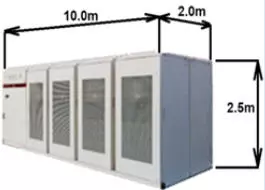
A Battery ‘Cabinet’ Unit Dimensions: - 10m x 2m x 2.5m deep Weight 6,000kg Power storage 1 MW
Dimensions Used in an Aberthaw-Minehead T-G box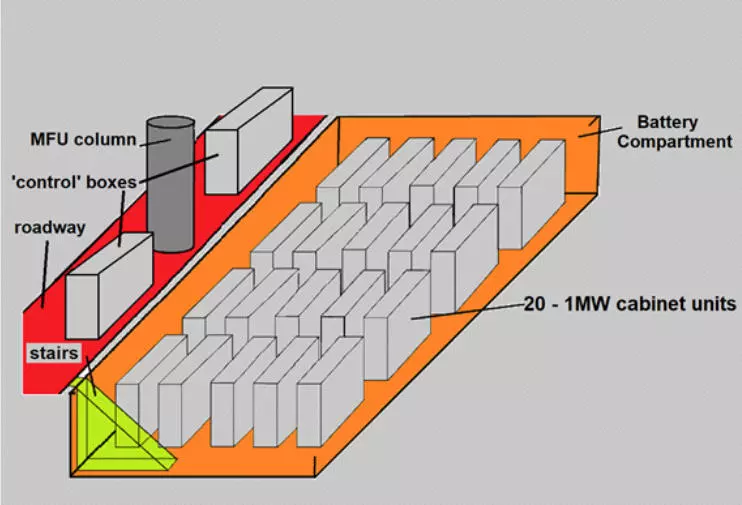
Battery Compartment - fully loaded with 20MW of cabinet units
Battery Compartment (one per T-G box)Dimensions: - 49m x 16m x 3m deep
Battery Storage: Maximum capacity 20MW
Control Boxes: Four, - two each side of the T-G box. (Between the MFU columns)
A T-G Box can safely contain a 20-megawatt section of a storage-battery array.
As shown the battery compartment is positioned so that its top, including the top of the stairway leading down into it, is level with the Machine Hall roadway. This ensures battery storage component access is at least 3m above the highest yearly tide water level.
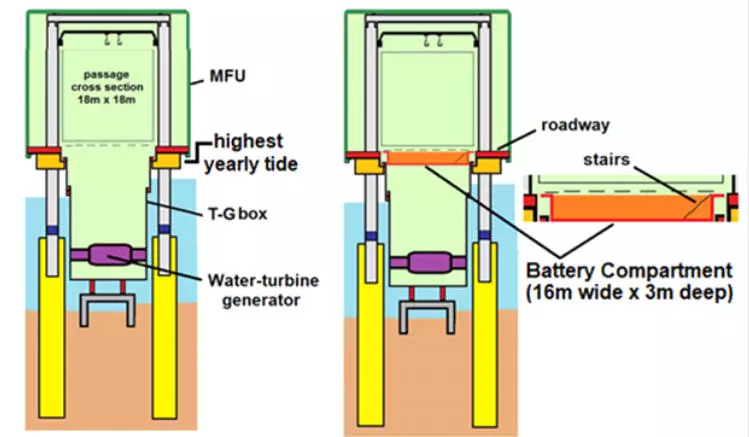 T-G box showing
T-G box showing
water-turbine/generatorT-G box showing
Battery Compartment location
Battery Compartment entrance is well above the highest yearly tide level
- The Selection Process (Water-turbine/Generators with 20MW Cabinet Units)
A potential contractor for a structural steel barrage between Aberthaw and Minehead can now consider the number, megawatt output rating and locations of water-turbine/generators that could be the basis of a ‘best commercial offer’.in the context of what could be available. The result takes in the very different flow patterns encountered when crossing the Bristol Channel.
The process of narrowing down the options taking into account the existing proven machines and the design capability available to the contractor follows. An example of how this process could be done is included.
Requirements
- Describe a barrage that can supply continuously to National Grid 4,000MW of electricity generated solely from tidal power by making use of storage-batteries.
- Utilise up to 240 T-G boxes.
- Determine
- A commercially usable flow/head regime at each T-G location.
- The design, power-rating and location of water-turbine/generators.
Selection Method
An example of Storage Battery distribution and Water-turbine/Generator distribution follows. This selection process starts with a ‘speculative’ opening arrangement that uses 13 of the 15 Machine Halls available. Each of the Machine Halls utilised contains 4 main frame units each of which contains a full set of 4 T-G boxes making a barrage total of 13 x 4 x 4 = 208 water-turbine/generators.
Battery distribution in the example
Machine Hall 1All 16 T-G boxes are fitted with a 20MW Battery Compartment and four ‘Control’ Boxes but no cabinets or water-turbine/generators. These are to provide responses to a ‘failure to function’ incident by providing everything essential to connectivity of a replacement water-turbine/generator.
- This option also could respond to major changes in later years in the flow channel course leading to a water-turbine intake.
- The option also could respond to the possibility of generating more than 4,000MW for the additional price of water-turbine/generator(s) etc. This allows the evaluation of a possible commercially viable option to be conducted after actual power generation experience has been acquired.
All 208 T-G boxes are fitted with a 20MW Battery Compartment and a full set of cabinets to enable provision of the 4,000MW requirement. This includes eight T-G boxes to accommodate equipment needed to respond to ‘failure to generate’. (8 x 20 =160MW).
Machine Hall 15
The example places a 20-megawatt Battery Compartment above each water-turbine. This is not a requirement. Storage batteries only need electrical connections so could, for example, be above an adjacent T-G box that does not contain a water-turbine.
The ‘speculative’ opening arrangement shows that the Aberthaw Tidal barrage is able to physically accommodate the Tesla 2017 battery design or its equivalent. A different water-turbine / generator choice could reduce their number from 200 to about 120.
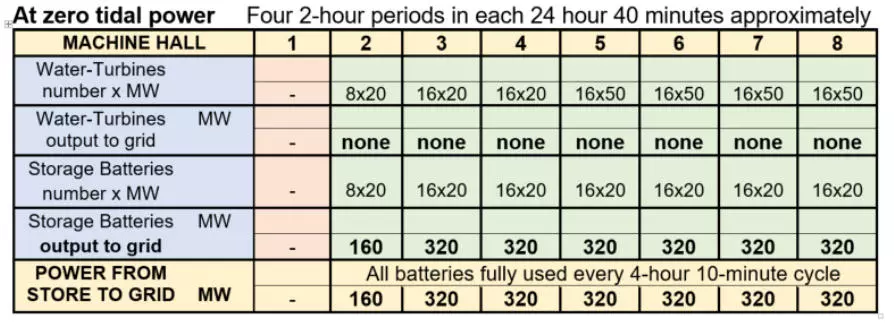
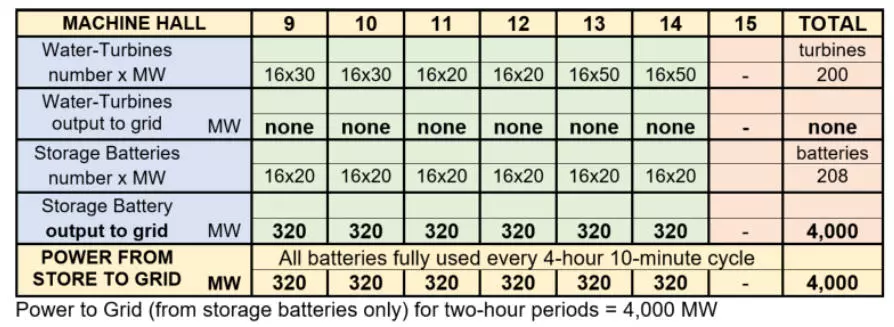
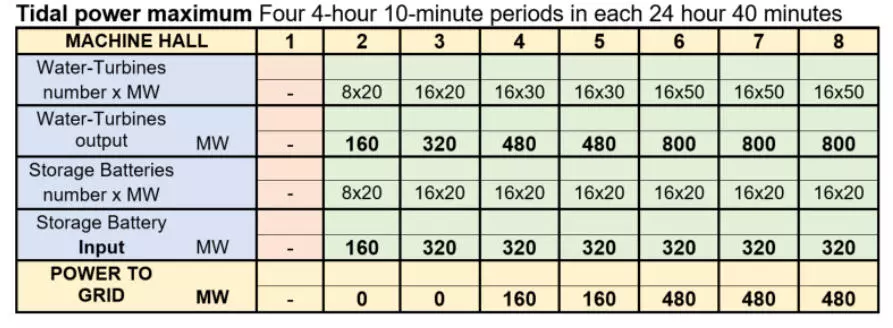
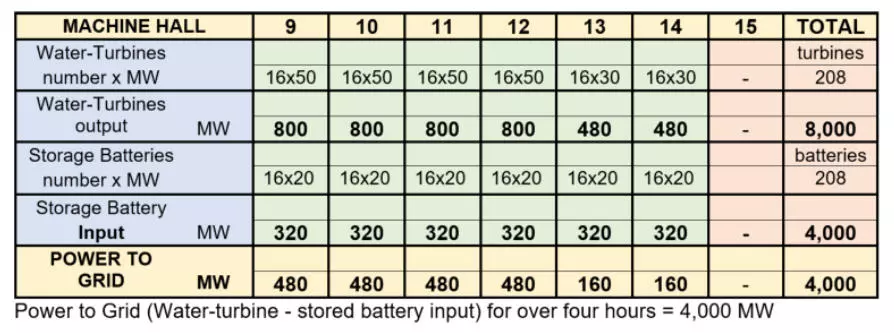
- The Selection Process (Water-turbine/Generators with 40MW Cabinet Units)
The potential for using the improved battery designs that will be available by the time the Aberthaw Tidal Power Station is approaching the ‘ready to generate’ stage can now be considered. This potential is enhanced considerably by the flexibility offered by removeable water-turbine / generator (T-G box) and battery compartment designs.
The use of Machine Hall 15 in large power battery development and testing is described in ‘Employment Opportunities’. It provides the UK with the opportunity to become a ‘world leader’ in any future design evaluation in an industrial scale testing environment.
Requirements
- Describe a barrage that can supply continuously to National Grid 4,000MW of electricity generated solely from tidal power by making use of storage-batteries.
- Utilise up to 240 T-G boxes.
- Determine
- A commercially usable flow/head regime at each T-G location.
- The design, power-rating and location of water-turbine/generators.
Storage Batteries available in 2024 for an Aberthaw Tidal Power Station
The requirements for storage batteries in a 2025 Aberthaw Tidal Power Station are now described to help set attainable development objectives and manufacturing timetables.
Machine Halls 2 to 14 To enable the contents of each Battery Compartment to have a life of at least ten years when meeting the most demanding requirement – four megawatts delivered continuously to National Grid - the batteries are ‘topped up’ over 12 hours 20 minutes (the lunar cycle). The requirement is met by 208 T-G Boxes fitted with both 40MW Battery Compartment and a full set of cabinet units. The storage capacity is 8320MW.
Additionally 136 T-G boxes have water-turbine/generators installed. The barrage battery charging cycle cycle of 12 hours 20 minutes is made up as (i) 4 hours 10 minutes on charge (ii) 2 hours ‘no-charge’ as the tide turns (iii) 4 hours 10 minutes on charge period and (iv) 2 hours ‘no-charge’ as the tide turns. This ensures batteries are never operate below 50% of their power rating even in the most challenging of operational conditions. If the barrage is set to meet only a daily power usage pattern the batteries would typically never operate below 80% of their power rating.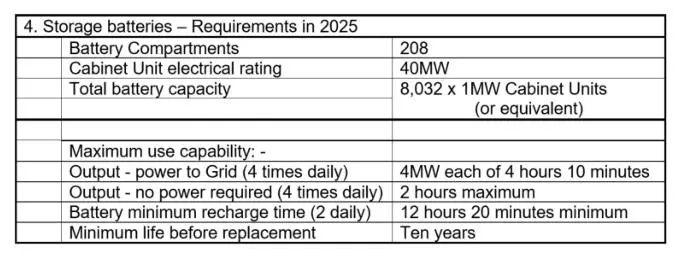
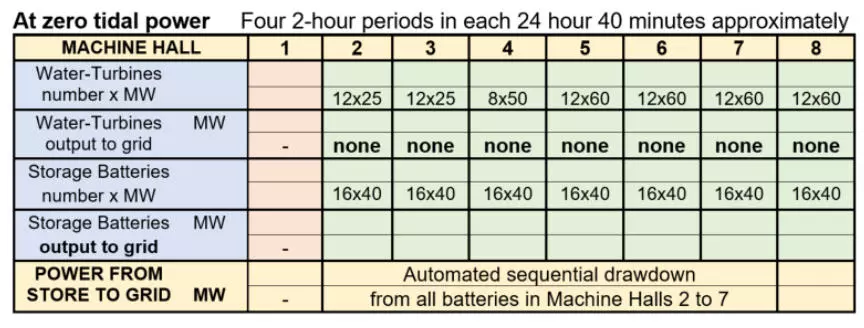
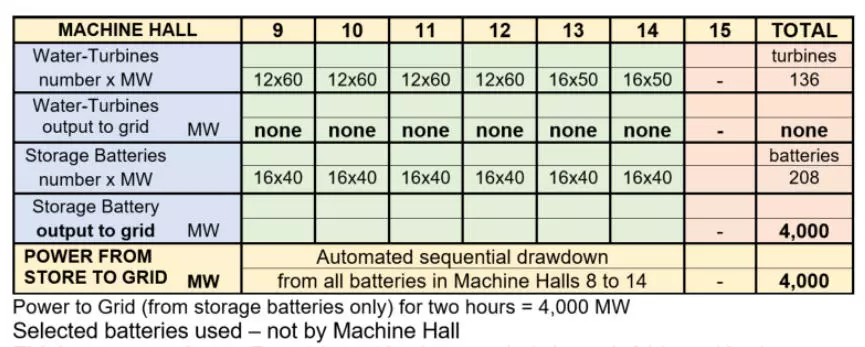

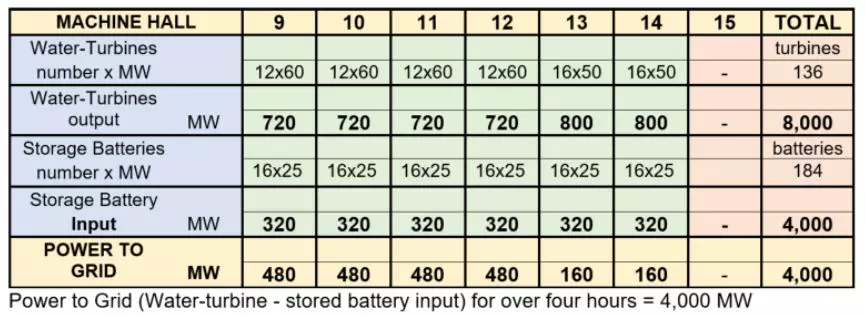
In the ‘Real World’.
The previous ‘speculative’ starter selection was based on an interplay of water-turbine operation, tidal ebb/flow and shipping channel bascule opening/closure. This approach is adequate for demonstrating that power generation requirements can be met by the Bristol Channel tides, the existing flow pattern from Aberthaw across to Minehead, and the Tesla battery design proven in Australia.The magnitude of power generation is underestimated by the above approach. Four examples show why this is so.
- The 54m shipping channel need not and will not be opened if no ships require to pass through it. Ships that have to use this channel (over 30,000 tonnes) are infrequent users of the upper estuary. Keeping the Shipping Channel closed increases the flow/head profile of the water entering the water-turbines.
- The largest ships use the 54m channel and sail ‘on the tide’. The economic advantage gained by travelling through the shipping channel in the same direction as a fast-moving flow is clear. The magnitude of flow crossing the line of the Aberthaw Tidal barrage near high tide depends on the difference between high and low tide. To take advantage of this the largest ships prefer to travel at the largest high tide difference. This benefits barrage power generation when lower tide differences occur.
- The availability of both shipping channels during the early-morning hours is usually operationally unnecessary making the closure to traffic of one or both an option.
- On the approach to low-tide it is essential that the upper estuary level is as low as practicable to maximise the next power generation cycle. To accommodate this need additional power generation at low water-turbine differential head levels will be permitted.